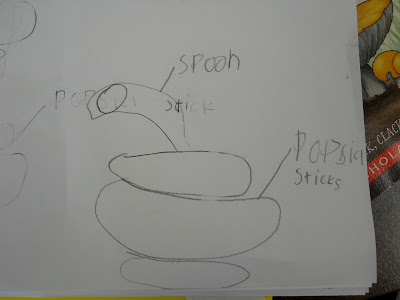We had snow last week and in our neck of the woods, snow is a novelty because it doesn't happen too often. When I heard the weather report and that the snow would likely disappear by the afternoon, I promptly shifted my morning plans to Monday. We spent the periods between recess and lunch immersed in snow fun, snow math, snow science and snow art.
How cold is snow?
We bundled up and headed outside to gather snow. Each person filled a cup full of snow. We came inside and used thermometers to measure how cold the snow was. We did a mini lesson on using a thermometer. It was great to hear their connections between a thermometer and when their parents take their temperature to check for a fever.
How long can you hold snow?
Next we had a little fun with a challenge, how long can you hold a handful of snow? Some kids held their snow for a minute, others for ten minutes. There was lots of discussion while they were holding snow about what they noticed and how cold it felt.
After these two activities, we sat in a sharing circle to share as scientists. Each person took a turn to share what did they notice (observe) and a wonder that they have about snow. After each person had a turn to share, the students wrote about their observations and wonders. Earlier in the week, they had written about snow as a poet, now we were looking at it through the lens of a scientist.
Some of their observations and wonders:
"When my thumb is on the red part of the thermometer the red goes up."
"My hand was really red after holding the snow, I wonder why it got red?"
" The snow melted and ran down my arm, I think it is because my hand is warm."
" I noticed that the snow is cold and wet."
" I wonder how snow melts?"
Salt and Snow
Before the students started writing, we set up one last experiment. We put out two plates of snow. One plate we added salt and the other we left as is. Periodically as we were writing, we checked on the status of our snow. Again I was so pleased with the connections that they were making to using salt on the sidewalks and why that might be. One of our goals, is to encourage students to make connections in their science and math. We want to carry over our connections in reading to other disciplines. Good readers make connections, but so do good scientists and good math mathematicians.
Art Collage and The Snowy Day
One of my favourite snow books and snow art project comes from The Snowy Day by Ezra Jack Keats.
After enjoying the book, the children were given a blue paper for the background and a white paper for the snow. Using scrap paper, they re-created a snow scene.
The final touch is to stamp or sponge paint snow to their picture in the style of the end pages in the book.
Any good snow lessons to share?



























































